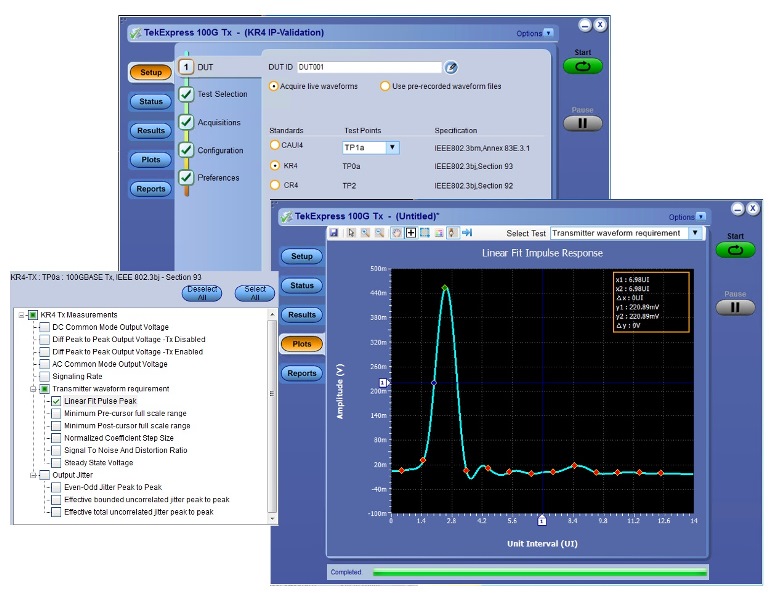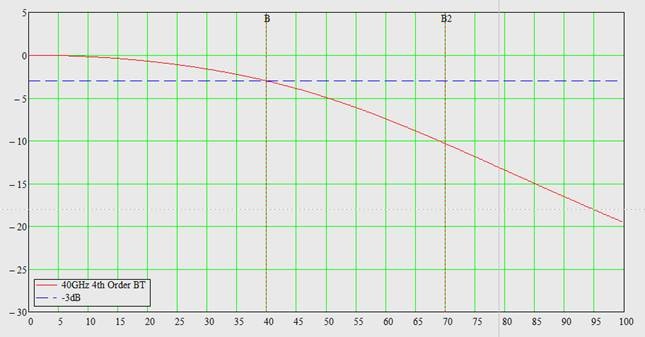BY RICHARD COMERFORD, Senior Technical Editor, Electronic Products
Last week, Tektronix, a leading worldwide provider of measurement solutions, introduced the new TekExpress application with automated compliance test solutions for four-lane 100G electrical interfaces defined in the IEEE 802.3bm and 802.3bj specifications.
Available for Tektronix performance oscilloscopes from 33 GHz up to 70 GHz, the $7,500 TekExpress supports 100G Ethernet (IEEE 802.3bj and IEEE 802.3bm Annex 83) electrical validation and characterization needs. Specific supported technologies are 100GBASE-CR4/KR4 and CAUI4, which are the principal electrical specifications for 100G Ethernet.
The IEEE 802.3 specification is some 2,200 pages long and continually evolving, making it challenging for test engineers to come up to speed on such a massive specification. Tektronix has had a deep involvement with the IEEE 802.3 and other standards bodies, and this has allowed it to leverage its expertise to help translate the standard’s test requirements into easy-to-use turnkey test solutions that offer clear and concise characterization reports (see Fig. 1 below). The company sees reducing test and validation complexity as key to bringing interchangeable 100G optical and electrical modules to market in a timely manner.

Fig. 1: TekExpress 100GBASE Tx measurement example.
I recently had the opportunity to speak with John Calvin, Performance Instruments Product Manager at Tektronix, about the introduction. In the course of our conversation, John mentioned that not only were real-time scopes operating at 70 GHz more than sufficient for this and the next generation of Ethernet technologies, but also that they were moving into a space formerly dominated by sampling scopes.
After our telephone discussion, John followed up with an e-mail that I found so eloquent and informative that I want to reproduce it here.
Greetings Richard,
It was a pleasure discussing DataCom with you this morning. This is a care package with images you're free to re-use.
A few comments on the business of why Real Time is now playing in a field traditionally dominated by Sampling Instruments:
The future of DataCom is clearly entrenched in heavily equalized signaling at speeds approaching 56 GBaud (112 Gbps) per lane. Clock recovery systems need to operate after the signal has been equalized, and this combination is either challenging (for the 28 GBaud case) or nonexistent (for the 56 GBaud case). This is the catalyst motivating many in this field to ask Tek to make a real-time-based DataCom solution.
The other challenge is SNDR (Signal to Noise and Distortion Ratio), which does not play well with typical real-time noise and ENOB levels. The combination of lowest noise performance in real-time (70000 SX Asynchronous Time Interleaved) acquisition systems in our new performance portfolio allows us to come within several dB of the equivalent SNDR calculation done on sampling instruments. This offers users the versatility and ease of use in real-time with nearly sampling-level precision.
Another related feature of the real-time analysis package for CAUI4/CR4/KR4 discussed here is that in a real-time solution, the actual waveforms analyzed in the conformance report are stored as well. This allows engineers to store away the source waveforms and recall or post-analyze them without the actual DUT at a later time. If someone complains about a particular jitter tone causing interference in a system 10 months after the silicon was first characterized, a designer can recall that original data and re-examine it without the actual part.
This is the 33-GHz Bessel Thompson response required by the IEEE specs in the 100G space:

Similarly, the OIF-CEI community has a slightly higher bandwidth spin on this at 40 GHz.

The bottom line is that this 'Bessel Thompson' vocabulary is integral to both of the most prominent 100G Standards (IEEE 802.3 and OIF-CEI). This requires additional instrumentation bandwidth to accommodate the long Bessel Thompson tail, typically to the −10dB point.
We spoke extensively about 802.3bj (KR4/CR4) and 802.3bm (CAUI4/SR4). We only briefly mentioned OIF-CEI. The reason for this is that the 100G OIF-CEI specs are largely being replaced by industrial-grade IEEE standards, which are superseding the older (circa 2009) OIF-CEI 100G specs. That said, OIF-CEI is leading the charge into 400G, which is kind of their thing. OIF-CEI are the scouts, and IEEE is the infantry.
Regards,
John Calvin, Performance Instruments Product Manager, Tektronix Inc.
Advertisement
Learn more about Tektronix





